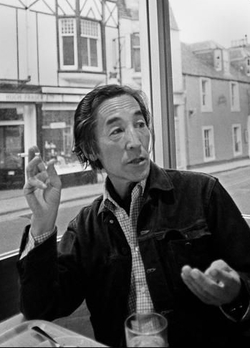Miyuki Miyabe is a Japanese writer of genre fiction. She has won numerous Japanese literary awards, including the Yoshikawa Eiji Prize for New Writers, the Yoshikawa Eiji Prize for Literature, the Shiba Ryotaro Prize, the Yamamoto Shūgorō Prize, and the Naoki Prize. Her work has been widely adapted for film, television, manga, and video games, and has been translated into over a dozen languages.

Science fiction is an important genre of modern Japanese literature that has strongly influenced aspects of contemporary Japanese pop culture, including anime, manga, video games, tokusatsu, and cinema.
Masao Horino was one of the most prominent Japanese photographers in the first half of the 20th century in Japan.

Kaidanji Oshikawa Shunrō: Nihon SF no Oya is a 1987 Japanese book by Jun'ya Yokota and Shingo Aizu about Shunro Oshikawa, the early twentieth century pioneer of Japanese science fiction. The book won the 1988 Nihon SF Taisho Award.
The Nihon SF Taishō Award is a Japanese science fiction award. It has been compared to the Nebula Award as it is given by the Science Fiction and Fantasy Writers of Japan or SFWJ. The Grand Prize is selected from not only Science Fiction novels, but also various SF movies, animations, and manga.
Maeda Nobuaki(前田 陳爾, 22 November 1907 – 3 July 1975) was a Japanese professional 9 dan go player, a disciple of Honinbo Shusai, and a member of the Nihon Ki-in, the main organizational body for go in Japan. His own disciples were Norio Kudo, Yusuke Oeda, Shioiri Itsuzo, Nagahara Yoshiaki, and Morikawa Masao.
Taikichi Irie was a Japanese photographer. He concentrated on Yamatoji and Buddhist statues.
Tadao Tominari was a Japanese nature photographer.

Hiroshi Hamaya was a Japanese photographer active from 1935 to 1999. In particular, Hamaya was known for his photographs of rural Japan.
Torishima, Tori-shima or Tori Shima, is a Japanese toponym or personal surname. Most versions of the name have the meaning Bird Island, with some exceptions.

The Japan Music Awards for outstanding achievements in the Broadcast Music Producers Federation, was major music awards show held annually in Japan from 1969 to 1993. The 1988 awards ceremony was cancelled due to the deteriorating health of Emperor Shōwa.

Ichimatsu Tanaka was a Japanese academic, art historian, curator, editor, and sometime public servant who specialized in the history of Japanese art.
Project Itoh, real name Satoshi Itō, was a Japanese science fiction writer and essayist.
Toh EnJoe is a Japanese author. Most of his works are literary fiction or speculative fiction.
The Kakitsu uprising was a peasant uprising demanding debt cancellation that occurred in 1441, the 1st year of Kakitsu, in Kyoto and surrounding areas such as Ōmi Province.
Tokyo Sogensha Co., Ltd. is a Japanese publisher of mystery fiction, science fiction, fantasy, literary fiction and social science, based in Tokyo.
The Tokyo Sports Puroresu Awards are Japanese professional wrestling, or puroresu, awards that have been handed out by the Tokyo Sports magazine annually since 1974. The most publicized awards in Japanese professional wrestling, they are recognized by all the major promotions in the country, including All Japan Pro Wrestling, New Japan Pro-Wrestling, and Pro Wrestling Noah.
Haneko Takayama is a Japanese writer. She has won the Akutagawa Prize and the Fumiko Hayashi Literary Prize, and her work has been nominated for the Nihon SF Taisho Award.
Jun'ya Yokota was a Japanese science fiction writer and a researcher of Meiji era cultural history. He is the winner of multiple Taisho Awards, the Ozaki Memorial Prize, and the Mystery Writers of Japan Award.
Dempow Torishima is a Japanese science-fiction writer and illustrator. He won the Sogen SF Short Story Prize in 2011. His novel Sisyphean was named SF Magazine's best Book of 2013, won the Japan SF Award, and was nominated for the Seiun Award in 2014. Science fiction writer Jeff VanderMeer described the book as "the Kafka of "Penal Colony" and "Metamorphosis" conjured up the ghosts of PK Dick and Leonora Carrington in the context of weird terrestrial biology + far future + Brothers Quay. It truly inhabits the lives of other lifeforms but is linear." The Los Angeles Review of Books called it "a remarkable literary feat", and noted its complex exploration of technology, the human body, biology, and post-capitalist science fiction.




